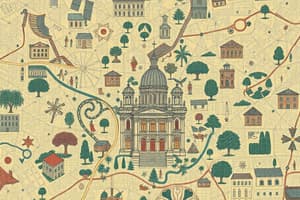Podcast
Questions and Answers
Which branch of geography focuses on the natural features and processes of the Earth?
Which branch of geography focuses on the natural features and processes of the Earth?
- Economic Geography
- Cultural Geography
- Human Geography
- Physical Geography (correct)
What is the term used for the spatial relationships of people and how ideas are exchanged?
What is the term used for the spatial relationships of people and how ideas are exchanged?
- Location
- Movement (correct)
- Region
- Place
Which tool is used for satellite-based navigation?
Which tool is used for satellite-based navigation?
- Thematic Maps
- Remote Sensing
- GPS (correct)
- Topographic Maps
What characteristic distinguishes a region in geography?
What characteristic distinguishes a region in geography?
What is the focus of economic geography?
What is the focus of economic geography?
What is the main goal of environmental sustainability?
What is the main goal of environmental sustainability?
Which type of map highlights specific themes like population density or climate?
Which type of map highlights specific themes like population density or climate?
Which of the following is a feature of human geography?
Which of the following is a feature of human geography?
Flashcards are hidden until you start studying
Study Notes
Major Branches of Geography
- Physical Geography: Examines natural features and processes.
- Landforms, climate, vegetation, and ecosystems.
- Human Geography: Studies human activities and their relationship with the environment.
- Urban development, cultural landscapes, and economic activities.
- Geographical Information Systems (GIS): Tools for mapping and analyzing spatial data.
Key Concepts in Geography
- Location:
- Absolute (exact coordinates) vs. Relative (position in relation to other locations).
- Place:
- Physical and human characteristics that define a location.
- Region:
- Areas defined by common features (cultural, physical, political).
- Movement:
- How people, goods, and ideas are transported and exchanged.
- Human-Environment Interaction:
- Ways humans adapt to and modify their environment.
Tools and Techniques
- Maps: Visual representations of geographic areas.
- Types include political, physical, thematic, and topographic maps.
- Remote Sensing: Gathering data from satellites or aircraft.
- GPS (Global Positioning System): Satellite-based navigation system.
Physical Geography
- Landforms: Mountains, valleys, plateaus, hills.
- Climates: Classification (tropical, arid, temperate).
- Ecosystems: Interaction of living organisms with their environment (forest, desert, aquatic).
Human Geography
- Population Geography: Study of population distribution, density, and trends.
- Cultural Geography: Exploration of cultural practices, languages, and beliefs.
- Economic Geography: Analysis of economic activities, trade, and resources distribution.
Environmental Geography
- Sustainability: Balance between human needs and environmental protection.
- Global Issues: Climate change, urbanization, and resource depletion.
- Conservation: Preservation and sustainable management of natural resources.
Notable Geographic Tools
- Topographic Maps: Show elevation and terrain features.
- Thematic Maps: Focus on specific themes (e.g., population density).
- Cartographic Techniques: Methods for map-making and data representation.
Geography's Impact
- Understanding Patterns: Helps in urban planning, disaster response, and resource management.
- Global Awareness: Encourages awareness of international issues and cultural diversity.
- Environmental Stewardship: Promotes sustainable practices and conservation efforts.
Major Branches of Geography
- Physical Geography studies the Earth's natural features and processes, including landforms, climate, vegetation, and ecosystems.
- Human Geography examines human activities and their relationship with the environment, covering aspects like urban development, cultural landscapes, and economic activities.
- Geographical Information Systems (GIS) are tools used for mapping and analyzing spatial data.
Key Concepts in Geography
- Location refers to a place's position, defined by absolute coordinates (exact position) or relative position (in relation to other locations).
- Place encompasses the physical and human characteristics that distinguish a specific location.
- Region is an area defined by shared features (cultural, physical, or political characteristics).
- Movement focuses on the transportation and exchange of people, goods, and ideas.
- Human-Environment Interaction explores how humans adapt to and modify their environment in a given location.
Tools and Techniques
- Maps are a visual representation of geographic areas, including political, physical, thematic, and topographic maps.
- Remote Sensing involves gathering data from satellites or aircraft.
- GPS (Global Positioning System) is a satellite-based navigation and location system.
Physical Geography
- Landforms encompass various geological features like mountains, valleys, plateaus, and hills.
- Climates are classified based on diverse weather patterns, including tropical, arid, and temperate climates.
- Ecosystems reflect the interaction of living organisms within specific environments, such as forests, deserts, and aquatic ecosystems.
Human Geography
- Population Geography focuses on population distribution, density, and trends.
- Cultural Geography explores cultural practices, languages, and beliefs across different locations.
- Economic Geography analyzes economic activities, trade patterns, and resource distribution.
Environmental Geography
- Sustainability emphasizes balancing human needs with environmental protection for a sustainable future.
- Global Issues include pressing environmental concerns like climate change, urbanization, and resource depletion.
- Conservation aims to preserve and sustainably manage natural resources for future generations.
Notable Geographic Tools
- Topographic Maps showcase elevation and terrain features for a better understanding of the landscape.
- Thematic Maps provide insights into specific themes, such as population density or resource distribution.
- Cartographic Techniques encompass methods for creating maps and representing geographic data effectively.
Geography's Impact
- Understanding Patterns: Geography helps in urban planning, disaster response, and resource management by identifying patterns and spatial relationships.
- Global Awareness: Geography promotes awareness of international issues and cultural diversity, fostering global understanding.
- Environmental Stewardship: Geography encourages sustainable practices and conservation efforts, promoting responsible environmental stewardship.
Studying That Suits You
Use AI to generate personalized quizzes and flashcards to suit your learning preferences.




